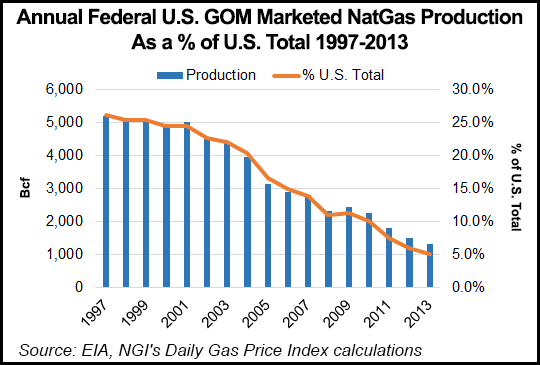Markets | NGI All News Access | NGI The Weekly Gas Market Report
El Nino Weighs Down NOAA’s 2014 Atlantic Hurricane Forecast
The National Oceanic and Atmospheric Administration (NOAA) added its name to the list of forecasters predicting a relatively mild 2014 Atlantic hurricane season, saying it expects eight to 13 named storms, including three to six hurricanes, one to two of them major (Category 3 or higher).

And like other tropical forecasters, NOAA said it anticipates the development in late summer of an El Nino event — the warming of water temperatures in the central and equatorial Pacific Ocean — will suppress the number and intensity of tropical storms in the Atlantic Basin.
“One way that El Nino suppresses Atlantic hurricane activity is by increasing the amount of wind shear, which inhibits cyclonic development and growth, and so reduces the number and the intensity of storms,” said NOAA Administrator Kathryn Sullivan. “El Ninos also increase the trade winds and the atmospheric stability across the Atlantic Basin, and those factors also make it even harder for hurricanes to develop.”
The expectation for near-average sea-surface temperatures in the Atlantic, which contrasts with above-average temperatures in recent years, also led to the near-normal to below-normal hurricane forecast, Sullivan said.
“Our scientists are seeing these climate features already starting to set up. We expect the trends to continue through hurricane season as El Nino continues to develop and shows what it true strength will be,” Sullivan said.
NOAA’s forecast is near the 1981-2010 seasonal average of 12 named storms, six hurricanes and three major hurricanes. There were 14 named storms last year, but only two of them became hurricanes, and none reached major hurricane status. Late in the hurricane season, Tropical Storm Karen forced natural gas and oil operations to be shut-in and dozens of platforms to be evacuated, but the storm weakened before doing any major damage (see Daily GPI, Oct. 7, 2013).
Weather Services International, AccuWeather.com, Colorado State University and ImpactWeather have all recently released forecasts calling for a relatively mild Atlantic hurricane season, and pointed to El Nino as the meteorological event holding down tropical storm development (see Daily GPI, May 19; May 15; April 11; March 25).
Sullivan said early testing on continued improvements to NOAA’s Hurricane Weather Research and Forecasting model shows a 10% improvement in this year’s model compared to last year.
Increased natural gas production from U.S. shale plays in recent years has lessened the potential impact of Gulf hurricanes on prices and supply (see Daily GPI, Sept. 18, 2013).
The emerging El Nino is also expected to bring a higher-than-normal frequency of cool Canadian air masses to the United States this summer, resulting in unusually weak cooling demand (see Daily GPI,May 16).
© 2024 Natural Gas Intelligence. All rights reserved.
ISSN © 1532-1231 | ISSN © 2577-9877 | ISSN © 1532-1266 |
